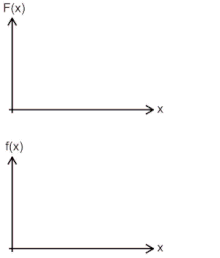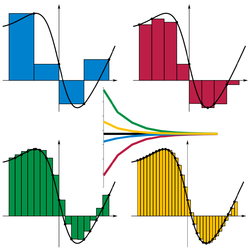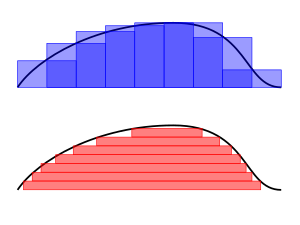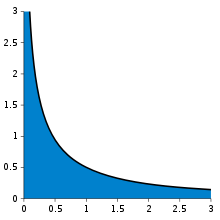提示 :此条目页的主题不是
得分 。
积分 (英語:Integral )是微积分 学与数学分析 裡的一个核心概念。通常分为定积分 和不定积分 两种。直观地说,对于一个给定的正 实值函数
f
(
x
)
{\displaystyle f(x)}
f
(
x
)
{\displaystyle f(x)}
区间
[
a
,
b
]
{\displaystyle [a,b]}
∫
a
b
f
(
x
)
d
x
{\displaystyle \int _{a}^{b}f(x)\,\mathrm {d} x}
可以在数值 上理解为在
O
x
y
{\displaystyle \textstyle Oxy}
曲线
(
x
,
f
(
x
)
)
{\displaystyle (x,f(x))}
x
∈
[
a
,
b
]
{\displaystyle x\in [a,b]}
x
=
a
{\displaystyle x=a}
x
=
b
{\displaystyle x=b}
x
{\displaystyle x}
曲边梯形 的面积 值[註 1]
函数
f
(
x
)
{\displaystyle f(x)}
f
(
x
)
{\displaystyle f(x)}
不定积分 (或原函数)是指任何满足导数 是函数
f
(
x
)
{\displaystyle f(x)}
函数
F
(
x
)
{\displaystyle F(x)}
f
(
x
)
{\displaystyle f(x)}
F
(
x
)
{\displaystyle F(x)}
f
(
x
)
{\displaystyle f(x)}
F
(
x
)
+
C
{\displaystyle F(x)+C}
f
{\displaystyle f}
[註 2]
微积分基本定理 是微积分学中的一条重要定理,由艾萨克·牛顿 和戈特弗里德·威廉·莱布尼茨 在十七世纪分别独立发现。微积分基本定理 将积分与微分 建立联系,通过找出一个函数的原函数,即可方便地计算它在一个区间上的积分。积分和导数 已成为高等数学中最基本的工具,并在自然科学和工程学中得到广泛运用。
积分的一个严格的数学定义由波恩哈德·黎曼 给出,因此习惯上我们常见的积分也称为“黎曼积分 ”。黎曼的定义运用了极限的概念,把曲边梯形设想为一系列矩形组合的极限。从十九世纪起,更高级的积分定义逐渐出现,有了对各种积分区间 上的各种类型的函数的积分。[註 3] 微分形式 的积分是微分几何 中的基本概念。
对积分概念的推广来自于物理学 的需要,并体现在许多重要的物理定律中,尤其是电动力学 。现代的积分概念基于测度论 ,主要是由昂利·勒貝格 建立的勒贝格积分 。
函数
f
{\displaystyle f}
■ 极大值(5部分)和■ 极小值(12部分) 积分发展的动力源自实际应用中的需求。实际操作中,有时候可以用粗略的方式进行估算一些未知量,但随着科技的发展,很多时候需要知道精确的数值。要求简单几何形体的面积或体积,可以套用已知的公式。[註 4] 位移 )对另一个物理量(比如力 )的累积效果,这时也需要用到积分。
什麼是積分(動畫 我们以下面这个问题作为介绍积分概念的开始:
考虑平方根 函数
f
:
x
↦
x
{\displaystyle f:\,x\mapsto {\sqrt {x}}}
x
∈
[
0
,
1
]
{\displaystyle x\in [0,\,1]}
f
{\displaystyle f}
问题中的“下方”面积,是指函数
y
=
f
(
x
)
{\displaystyle y=f(x)}
S
{\displaystyle S}
f
{\displaystyle f}
S
=
∫
0
1
x
d
x
.
{\displaystyle S=\int _{0}^{1}{\sqrt {x}}\,\mathrm {d} x\,\!.}
其中的
d
x
{\displaystyle \mathrm {d} x}
积分变量 ,表示要求面积的范围是用坐标轴横轴的刻度计算;
∫
0
1
{\displaystyle \int _{0}^{1}}
积分范围 或积分域 ,其中0称为积分下界 ,1称为积分上界 ,
∫
{\displaystyle \int }
积分号 ,是从拉长的字母S[註 5]
x
{\displaystyle {\sqrt {x}}}
被积函数 。[註 6]
改进的方法是用更多的小方框来将函数图象“覆盖”,如右图中的做法,就是将坐标轴横轴[0,1]等分成5个部分:[0,0.2)、[0.2,0.4)、[0.4,0.6)、[0.6,0.8)、[0.8,1],然后每一部分上放一个黄色的长方形(见右图■ )。这5个长方形的高度分别是函数在每个部分的极大值(也就是最右侧的值):
0.2
{\displaystyle {\sqrt {0.2}}}
0.4
{\displaystyle {\sqrt {0.4}}}
0.6
{\displaystyle {\sqrt {0.6}}}
0.8
{\displaystyle {\sqrt {0.8}}}
1
{\displaystyle 1}
S
{\displaystyle S}
0.2
(
0.2
−
0
)
+
0.4
(
0.4
−
0.2
)
+
0.6
(
0.6
−
0.4
)
+
0.8
(
0.8
−
0.6
)
+
1
(
1
−
0.8
)
≈
0.7497.
{\displaystyle {\sqrt {0.2}}\left(0.2-0\right)+{\sqrt {0.4}}\left(0.4-0.2\right)+{\sqrt {0.6}}\left(0.6-0.4\right)+{\sqrt {0.8}}\left(0.8-0.6\right)+{\sqrt {1}}\left(1-0.8\right)\approx 0.7497.\,\!}
求出了
S
{\displaystyle S}
S
{\displaystyle S}
■ ),那么从图中可以看出,
S
{\displaystyle S}
0
12
(
1
12
−
0
)
+
1
12
(
2
12
−
1
12
)
+
⋯
+
11
12
(
1
−
11
12
)
≈
0.6203.
{\displaystyle {\sqrt {\frac {0}{12}}}\left({\frac {1}{12}}-0\right)+{\sqrt {\frac {1}{12}}}\left({\frac {2}{12}}-{\frac {1}{12}}\right)+\cdots +{\sqrt {\frac {11}{12}}}\left(1-{\frac {11}{12}}\right)\approx 0.6203.\,\!}
于是,面积
S
{\displaystyle S}
S
{\displaystyle S}
S
{\displaystyle S}
以上的方法可能出现的“漏洞”,是所谓的“取值范围”不一定会越来越小,最后聚集到同一个值上。虽然直观上来说,由于函数下方的图形面积是确定的,只要不断地用相似的形状“逼近”,最后总会趋向函数下方图形的真实面积 。然而,对于某些“病态”的函数,以上的方法是无法得到确定的数值的。十九世纪的数学家波恩哈德·黎曼 证明了,对于满足某些条件的良态函数,以上的方法一定能求出函数下方的面积。现代的数学家将这种方法求出的面积称为黎曼积分 ,并给出了严格的定义(见#严格定义 一节)。对于那些无法用黎曼的方法定义“函数下方图形面积”的函数,黎曼之后的数学家发展出了一些更宽泛的定义,让这些函数也能定义积分。
术语和标记 [ 编辑 ] 如果一个函数的积分存在,并且有限,就说这个函数是可积的 。一般来说,被积函数不一定只有一个变量 ,积分域也可以是不同维度 的空间,甚至是没有直观几何意义的抽象空间。如同上面介绍的,对于只有一个变量
x
{\displaystyle x}
f
{\displaystyle f}
f
{\displaystyle f}
[
a
,
b
]
{\displaystyle [a,b]}
∫
a
b
f
(
x
)
d
x
.
{\displaystyle \int _{a}^{b}f(x)\,\mathrm {d} x.}
其中的
d
x
{\displaystyle \mathrm {d} x}
x
{\displaystyle x}
f
{\displaystyle f}
积分变量 )之外,还可以表示不同的含义。在黎曼积分中,
d
x
{\displaystyle \mathrm {d} x}
勒贝格积分 中,表示一个测度 ;或仅仅表示一个独立的量(微分形式 )。一般的区间或者积分范围
J
{\displaystyle J}
J
{\displaystyle J}
∫
J
f
(
x
)
d
x
.
{\displaystyle \int _{J}f(x)\,\mathrm {d} x.}
如果变量不只一个,比如说在二重积分 中,函数
f
(
x
,
y
)
{\displaystyle f(x,y)\,\!}
∬
D
f
(
x
,
y
)
d
σ
{\displaystyle \iint _{D}f(x,y)\,\!\,\mathrm {d} \sigma }
∬
D
f
(
x
,
y
)
d
x
d
y
{\displaystyle \iint _{D}f(x,y)\,\!\,\mathrm {d} x\mathrm {d} y}
其中
d
σ
{\displaystyle \mathrm {d} \sigma }
微分元 。
严格定义 [ 编辑 ] 定义积分的方法不止一种,各种定义之间也不是完全等价的。其中的差别主要是在定义某些特殊的函数:在某些积分的定义下这些函数不可积分,但在另一些定义之下它们的积分存在。然而有时也会因为教学的原因造成定义上的差别。最常见的积分定义是黎曼积分 和勒贝格积分 。
黎曼积分 [ 编辑 ] 在闭区间上取定一个(不规则的)取样分割后获得的黎曼和 黎曼积分得名于德国数学家波恩哈德·黎曼 ,建立在函数在区间取样分割后的黎曼和之上。设有闭区间
[
a
,
b
]
{\displaystyle [a,b]}
[
a
,
b
]
{\displaystyle [a,b]}
分割 是指在此区间中取一个有限的点列
a
=
x
0
<
x
1
<
x
2
<
…
<
x
n
=
b
{\displaystyle a=x_{0}<x_{1}<x_{2}<\ldots <x_{n}=b}
[
x
i
,
x
i
+
1
]
{\displaystyle [x_{i},x_{i+1}]}
λ
{\displaystyle \lambda }
λ
=
max
(
x
i
+
1
−
x
i
)
{\displaystyle \lambda =\max(x_{i+1}-x_{i})}
0
≤
i
≤
n
−
1
{\displaystyle 0\leq i\leq n-1}
[
a
,
b
]
{\displaystyle [a,b]}
取样分割 是指在进行分割
a
=
x
0
<
x
1
<
x
2
<
…
<
x
n
=
b
{\displaystyle a=x_{0}<x_{1}<x_{2}<\ldots <x_{n}=b}
[
x
i
,
x
i
+
1
]
{\displaystyle [x_{i},x_{i+1}]}
x
i
≤
t
i
≤
x
i
+
1
{\displaystyle x_{i}\leq t_{i}\leq x_{i+1}}
确定的子区间上不同的取样方式构成的黎曼和:■ 右端值,■ 极小值, ■ 极大值, ■ 左端值。 对一个在闭区间
[
a
,
b
]
{\displaystyle [a,b]}
f
{\displaystyle f}
f
{\displaystyle f}
x
0
,
…
,
x
n
{\displaystyle x_{0},\ldots ,x_{n}}
t
0
,
…
,
t
n
−
1
{\displaystyle t_{0},\ldots ,t_{n-1}}
黎曼和 定义为以下和式:
∑
i
=
0
n
−
1
f
(
t
i
)
(
x
i
+
1
−
x
i
)
{\displaystyle \sum _{i=0}^{n-1}f(t_{i})(x_{i+1}-x_{i})}
和式中的每一项是子区间长度
x
i
+
1
−
x
i
{\displaystyle x_{i+1}-x_{i}}
t
i
{\displaystyle t_{i}}
函数值
f
(
t
i
)
{\displaystyle f(t_{i})}
t
i
{\displaystyle t_{i}}
距离 为高,以分割的子区间为长的矩形 的面积。
最简单的取样分割方法是将区间均匀地分成若干个长度相等的子区间,然后在每个子区间上按相同的准则取得标记点。例如取每个子区间右端
t
i
=
x
i
+
1
{\displaystyle t_{i}=x_{i+1}}
t
i
{\displaystyle t_{i}}
λ
{\displaystyle \lambda }
极限 ,那么这个极限就叫做函数
f
{\displaystyle f}
[
a
,
b
]
{\displaystyle [a,b]}
S
{\displaystyle S}
f
{\displaystyle f}
[
a
,
b
]
{\displaystyle [a,b]}
ϵ
>
0
{\displaystyle \epsilon >0}
δ
>
0
{\displaystyle \delta >0}
x
0
,
…
,
x
n
{\displaystyle x_{0},\ldots ,x_{n}}
t
0
,
…
,
t
n
−
1
{\displaystyle t_{0},\ldots ,t_{n-1}}
λ
≤
δ
{\displaystyle \lambda \leq \delta }
|
∑
i
=
0
n
−
1
f
(
t
i
)
(
x
i
+
1
−
x
i
)
−
S
|
<
ϵ
.
{\displaystyle \left|\sum _{i=0}^{n-1}f(t_{i})(x_{i+1}-x_{i})-S\right|<\epsilon .\,}
也就是说,对于一个函数
f
{\displaystyle f}
[
a
,
b
]
{\displaystyle [a,b]}
f
{\displaystyle f}
S
{\displaystyle S}
f
{\displaystyle f}
[
a
,
b
]
{\displaystyle [a,b]}
S
{\displaystyle S}
f
{\displaystyle f}
黎曼可积 的。将
f
{\displaystyle f}
[
a
,
b
]
{\displaystyle [a,b]}
∫
a
b
f
(
x
)
d
x
.
{\displaystyle \int _{a}^{b}f(x)\mathrm {d} x.}
勒贝格积分 [ 编辑 ] 勒贝格积分的出现源于概率论 等理论中对更为不规则的函数的处理需要。黎曼积分无法处理这些函数的积分问题。因此,需要更为广义化 的积分概念,使得更多的函数能够定义积分。同时,对于黎曼可积的函数,新积分的定义不应当与之冲突。勒贝格积分就是这样的一种积分。 黎曼积分对初等函数 和分段连续的函数定义了积分的概念,勒贝格积分则将积分的定义推广到测度空间 裡。[1] :Intro.2-3
勒贝格积分的概念定义在测度 的概念上。测度是日常概念中测量长度、面积的推广,将其以公理化的方式定义。黎曼积分实际可以看成是用一系列矩形来尽可能铺满函数曲线下方的图形,而每个矩形的面积是长乘宽,或者说是两个区间之长度的乘积。测度为更一般的空间中的集合定义了类似长度的概念,从而能够“测量”更不规则的函数曲线下方图形的面积,从而定义积分。在一维实空间中,一个区间 A = [a , b ] 的勒贝格测度μ(A )是区间的右端值减去左端值, b − a 。这使得勒贝格积分和正常意义上的黎曼积分相兼容。在更复杂的情况下,积分的集合可以更加复杂,不再是区间,甚至不再是区间的交集或并集,其“长度”则由测度来给出。[1] :Intro.3
给定一个集合
Ω
{\displaystyle \Omega }
σ
−
{\displaystyle \sigma -}
F
{\displaystyle {\mathcal {F}}}
F
{\displaystyle {\mathcal {F}}}
μ
{\displaystyle \mu }
F
{\displaystyle {\mathcal {F}}}
A
⊂
Ω
{\displaystyle A\subset \Omega }
指示函数
1
A
{\displaystyle 1_{A}}
μ
{\displaystyle \mu }
黎曼积分(蓝色)和勒贝格积分(红色)
∫
1
A
d
μ
=
μ
(
A
)
{\displaystyle \int 1_{A}\,\mathrm {d} \mu =\mu (A)}
再定义可测的非负简单函数
f
=
∑
i
=
1
n
a
i
1
A
i
{\displaystyle f=\sum _{i=1}^{n}a_{i}1_{A_{i}}}
A
i
∈
F
,
a
i
⩾
0
{\displaystyle A_{i}\in {\mathcal {F}},\,\,a_{i}\geqslant 0}
∫
f
d
μ
=
∫
(
∑
i
=
1
n
a
i
1
A
i
)
d
μ
=
∑
i
=
1
n
a
i
∫
1
A
i
d
μ
=
∑
i
=
1
n
a
i
μ
(
A
i
)
{\displaystyle \int f\,\mathrm {d} \mu =\int \left(\sum _{i=1}^{n}a_{i}1_{A_{i}}\right)\,\mathrm {d} \mu =\sum _{i=1}^{n}a_{i}\int 1_{A_{i}}\,\mathrm {d} \mu =\sum _{i=1}^{n}a_{i}\mu (A_{i})}
[1] :28 对于一般的函数
f
:
Ω
→
R
{\displaystyle f:\Omega \rightarrow \mathbb {R} }
(
a
,
b
]
{\displaystyle (a,b]}
f
−
1
(
(
a
,
b
]
)
∈
F
{\displaystyle f^{-1}\left((a,b]\right)\in {\mathcal {F}}}
f
{\displaystyle f}
非负的可测函数
f
{\displaystyle f}
∫
f
d
μ
=
sup
{
g
,
g
{\displaystyle \int f\,\mathrm {d} \mu =\sup {\bigg \{}g,\quad g}
f
−
g
{\displaystyle f-g}
.
}
{\displaystyle .\,{\bigg \}}}
[1] :30 这个积分可以用以下的方式逼近:
∫
f
d
μ
=
lim
n
→
+
∞
[
∑
k
=
0
n
2
n
−
1
k
2
n
μ
(
k
2
n
⩽
f
<
k
+
1
2
n
)
+
n
μ
(
f
⩾
n
)
]
=
lim
n
→
+
∞
[
1
2
n
∑
k
=
0
n
2
n
−
1
μ
(
k
2
n
⩽
f
)
]
{\displaystyle \int f\,\mathrm {d} \mu =\lim _{n\to +\infty }\left[\sum _{k=0}^{n2^{n}-1}{\frac {k}{2^{n}}}\mu \left({\frac {k}{2^{n}}}\leqslant f<{\frac {k+1}{2^{n}}}\right)+n\mu (f\geqslant n)\right]=\lim _{n\to +\infty }\left[{\frac {1}{2^{n}}}\sum _{k=0}^{n2^{n}-1}\mu \left({\frac {k}{2^{n}}}\leqslant f\right)\right]}
[2] :344 直观上,这种逼近方式是将
f
{\displaystyle f}
Folland )[3] a , b ]划分为子区间”,而勒贝格积分则是“划分
f
{\displaystyle f}
至于一般的(有正有负的)可测函数
f
{\displaystyle f}
f
+
:
{\displaystyle f^{+}:}
f
(
x
)
⩾
0
,
{\displaystyle f(x)\geqslant 0,}
f
+
(
x
)
=
f
(
x
)
,
{\displaystyle f^{+}(x)=f(x),}
f
+
(
x
)
=
0.
{\displaystyle f^{+}(x)=0.}
f
−
:
{\displaystyle f^{-}:}
f
(
x
)
⩽
0
,
{\displaystyle f(x)\leqslant 0,}
f
−
(
x
)
=
−
f
(
x
)
,
{\displaystyle f^{-}(x)=-f(x),}
f
−
(
x
)
=
0.
{\displaystyle f^{-}(x)=0.}
可以验证,总有
f
(
x
)
=
f
+
(
x
)
−
f
−
(
x
)
.
{\displaystyle f(x)=f^{+}(x)-f^{-}(x).}
f
{\displaystyle f}
∫
f
d
μ
=
∫
f
+
d
μ
−
∫
f
−
d
μ
{\displaystyle \int f\,\mathrm {d} \mu =\int f^{+}\,\mathrm {d} \mu -\int f^{-}\,\mathrm {d} \mu }
[1] :41-42 [2] :345
以上定义有意义仅当
∫
f
+
d
μ
{\displaystyle \int f^{+}\,\mathrm {d} \mu }
∫
f
−
d
μ
{\displaystyle \int f^{-}\,\mathrm {d} \mu }
f
{\displaystyle f}
积分存在 或积分有意义 。如果
∫
f
+
d
μ
{\displaystyle \int f^{+}\,\mathrm {d} \mu }
∫
f
−
d
μ
{\displaystyle \int f^{-}\,\mathrm {d} \mu }
f
{\displaystyle f}
可积 。[1] :42-45 [2] :345
给定一个可测集合
A
{\displaystyle A}
A
{\displaystyle A}
∫
A
f
d
μ
=
∫
f
1
A
d
μ
.
{\displaystyle \int _{A}f\,\mathrm {d} \mu =\int f1_{A}\,\mathrm {d} \mu .}
[2] :345 其他定义 [ 编辑 ] 除了黎曼积分和勒贝格积分以外,还有若干不同的积分定义,适用于不同种类的函数。
达布积分 :等价于黎曼积分的一种定义,比黎曼积分更加简单,可用来帮助定义黎曼积分。黎曼-斯蒂尔杰斯积分 :黎曼积分的推广,用一般的函数g(x)代替x作为积分变量,也就是将黎曼和中的
(
x
i
+
1
−
x
i
)
{\displaystyle (x_{i+1}-x_{i})}
(
g
(
x
i
+
1
)
−
g
(
x
i
)
)
{\displaystyle (g(x_{i+1})-g(x_{i}))}
勒贝格-斯蒂尔杰斯积分 :勒贝格积分的推广,推广方式类似于黎曼-斯蒂尔杰斯积分,用有界变差函数 g代替测度
μ
{\displaystyle \mu }
哈尔积分:由阿尔弗雷德·哈尔于1933年引入,用来处理局部紧拓扑群上的可测函数的积分,参见哈尔测度 。
伊藤积分 :由伊藤清 于二十世纪五十年代引入,用于计算包含随机过程 如维纳过程 或半鞅 的函数的积分。通常意义上的积分都满足一些基本的性质。以下的
I
{\displaystyle {\mathcal {I}}}
积分是线性的。如果一个函数
f
{\displaystyle f}
f
{\displaystyle f}
g
{\displaystyle g}
∫
I
(
α
f
+
β
g
)
=
α
∫
I
f
+
β
∫
I
g
{\displaystyle \int _{\mathcal {I}}(\alpha f+\beta g)=\alpha \int _{\mathcal {I}}f+\beta \int _{\mathcal {I}}g\,}
所有在
I
{\displaystyle {\mathcal {I}}}
线性空间 。黎曼积分的意义上,所有区间[a , b ]上黎曼可积的函数
f
{\displaystyle f}
g
{\displaystyle g}
∫
a
b
(
α
f
+
β
g
)
(
x
)
d
x
=
α
∫
a
b
f
(
x
)
d
x
+
β
∫
a
b
g
(
x
)
d
x
.
{\displaystyle \int _{a}^{b}(\alpha f+\beta g)(x)\,\mathrm {d} x=\alpha \int _{a}^{b}f(x)\,\mathrm {d} x+\beta \int _{a}^{b}g(x)\,\mathrm {d} x.\,}
所有在可测集合
I
{\displaystyle {\mathcal {I}}}
f
{\displaystyle f}
g
{\displaystyle g}
∫
I
(
α
f
+
β
g
)
d
μ
=
α
∫
I
f
d
μ
+
β
∫
I
g
d
μ
.
{\displaystyle \int _{\mathcal {I}}(\alpha f+\beta g)\,\mathrm {d} \mu =\alpha \int _{\mathcal {I}}f\,\mathrm {d} \mu +\beta \int _{\mathcal {I}}g\,\mathrm {d} \mu .}
在积分区域上,积分有可加性。黎曼积分意义上,如果一个函数
f
{\displaystyle f}
∫
a
c
f
(
x
)
d
x
=
∫
a
b
f
(
x
)
d
x
+
∫
b
c
f
(
x
)
d
x
{\displaystyle \int _{a}^{c}f(x)\,\mathrm {d} x=\int _{a}^{b}f(x)\,\mathrm {d} x+\int _{b}^{c}f(x)\,\mathrm {d} x\,}
如果函数
f
{\displaystyle f}
I
{\displaystyle {\mathcal {I}}}
J
{\displaystyle {\mathcal {J}}}
∫
I
∪
J
f
d
μ
=
∫
I
f
d
μ
+
∫
J
f
d
μ
.
{\displaystyle \int _{{\mathcal {I}}\cup {\mathcal {J}}}f\,\mathrm {d} \mu =\int _{\mathcal {I}}f\,\mathrm {d} \mu +\int _{\mathcal {J}}f\,\mathrm {d} \mu .}
如果函数
f
{\displaystyle f}
ϵ
>
0
{\displaystyle \epsilon >0}
δ
{\displaystyle \delta }
F
{\displaystyle {\mathcal {F}}}
A
{\displaystyle A}
μ
(
A
)
<
δ
{\displaystyle \mu (A)<\delta }
∫
A
|
f
|
d
μ
<
ϵ
{\displaystyle \int _{A}\left|f\right|\,\mathrm {d} \mu <\epsilon }
保号性 [ 编辑 ] 如果一个函数
f
{\displaystyle f}
f
{\displaystyle f}
几乎总是 大于等于零,那么它的勒贝格积分也大于等于零。作为推论,如果两个
I
{\displaystyle {\mathcal {I}}}
f
{\displaystyle f}
g
{\displaystyle g}
f
{\displaystyle f}
g
{\displaystyle g}
f
{\displaystyle f}
g
{\displaystyle g}
如果黎曼可积的非负函数
f
{\displaystyle f}
I
{\displaystyle {\mathcal {I}}}
f
=
0
{\displaystyle f=0}
f
{\displaystyle f}
I
{\displaystyle {\mathcal {I}}}
f
{\displaystyle f}
F
{\displaystyle {\mathcal {F}}}
A
{\displaystyle A}
μ
(
A
)
{\displaystyle \mu (A)}
A
{\displaystyle A}
函数的积分表示了函数在某个区域上的整体性质,改变函数某点的取值不会改变它的积分值。对于黎曼可积的函数,改变有限个点的取值,其积分不变。对于勒贝格可积的函数,某个测度为0的集合上的函数值改变,不会影响它的积分值。如果两个函数几乎处处相同,那么它们的积分相同。如果对
F
{\displaystyle {\mathcal {F}}}
A
{\displaystyle A}
f
{\displaystyle f}
A
{\displaystyle A}
g
{\displaystyle g}
A
{\displaystyle A}
f
{\displaystyle f}
g
{\displaystyle g}
介值性质 [ 编辑 ] 如果
f
{\displaystyle f}
I
{\displaystyle {\mathcal {I}}}
M
{\displaystyle M}
m
{\displaystyle m}
f
{\displaystyle f}
I
{\displaystyle {\mathcal {I}}}
m
L
(
I
)
⩽
∫
I
f
⩽
M
L
(
I
)
{\displaystyle mL({\mathcal {I}})\leqslant \int _{\mathcal {I}}f\leqslant ML({\mathcal {I}})}
其中的
L
(
I
)
{\displaystyle L({\mathcal {I}})}
I
{\displaystyle {\mathcal {I}}}
I
{\displaystyle {\mathcal {I}}}
绝对连续性 [ 编辑 ] 积分的绝对连续性表明,如果函数在某区间或集合上可积,那么当积分区域是近乎全区域的时候,积分的值也会逼近在全区域上的积分值。如果函数
f
{\displaystyle f}
I
{\displaystyle {\mathcal {I}}}
I
n
⊂
I
n
+
1
{\displaystyle {\mathcal {I}}_{n}\subset {\mathcal {I}}_{n+1}}
lim
n
→
∞
I
n
=
I
{\displaystyle \lim _{n\to \infty }{\mathcal {I}}_{n}={\mathcal {I}}}
(
I
n
)
n
∈
N
{\displaystyle \left({\mathcal {I}}_{n}\right)_{n\in \mathbb {N} }}
lim
n
→
∞
∫
I
n
f
(
x
)
d
x
=
∫
I
f
(
x
)
d
x
{\displaystyle \lim _{n\to \infty }\int _{{\mathcal {I}}_{n}}f(x)\,\mathrm {d} x=\int _{\mathcal {I}}f(x)\,\mathrm {d} x}
积分不等式 [ 编辑 ] 涉及积分的基本不等式可以看作是一些离散不等式的类比。如柯西不等式 的积分版本:假如有函数
f
{\displaystyle f}
g
{\displaystyle g}
f
g
{\displaystyle fg}
f
2
{\displaystyle f^{2}}
g
2
{\displaystyle g^{2}}
I
{\displaystyle {\mathcal {I}}}
(
∫
I
(
f
g
)
(
x
)
d
x
)
2
≤
(
∫
I
f
(
x
)
2
d
x
)
(
∫
I
g
(
x
)
2
d
x
)
.
{\displaystyle \left(\int _{\mathcal {I}}(fg)(x)\,\mathrm {d} x\right)^{2}\leq \left(\int _{\mathcal {I}}f(x)^{2}\,\mathrm {d} x\right)\left(\int _{\mathcal {I}}g(x)^{2}\,\mathrm {d} x\right).}
而更广泛的赫尔德不等式 也有积分版本。设有正实数
p
{\displaystyle p}
q
{\displaystyle q}
1
p
+
1
q
=
1
{\displaystyle {\frac {1}{p}}+{\frac {1}{q}}=1}
f
{\displaystyle f}
g
{\displaystyle g}
|
∫
f
(
x
)
g
(
x
)
d
x
|
⩽
(
∫
|
f
(
x
)
|
p
d
x
)
1
p
(
∫
|
g
(
x
)
|
q
d
x
)
1
q
.
{\displaystyle \left|\int f(x)g(x)\,\mathrm {d} x\right|\leqslant \left(\int \left|f(x)\right|^{p}\,\mathrm {d} x\right)^{\frac {1}{p}}\left(\int \left|g(x)\right|^{q}\,\mathrm {d} x\right)^{\frac {1}{q}}.}
可以看出柯西不等式是赫尔德不等式在
p
=
q
=
2
{\displaystyle p=q=2}
此外闵可夫斯基不等式 也有积分版本。设有正实数
p
⩾
1
{\displaystyle p\geqslant 1}
f
{\displaystyle f}
g
{\displaystyle g}
(
∫
|
f
(
x
)
+
g
(
x
)
|
p
d
x
)
1
p
≤
(
∫
|
f
(
x
)
|
p
d
x
)
1
p
+
(
∫
|
g
(
x
)
|
p
d
x
)
1
p
.
{\displaystyle \left(\int \left|f(x)+g(x)\right|^{p}\,\mathrm {d} x\right)^{\frac {1}{p}}\leq \left(\int \left|f(x)\right|^{p}\,\mathrm {d} x\right)^{\frac {1}{p}}+\left(\int \left|g(x)\right|^{p}\,\mathrm {d} x\right)^{\frac {1}{p}}.}
对于勒贝格可积的函数,类似的不等式可以帮助构建
L
p
{\displaystyle L^{p}}
一个函数
f
{\displaystyle f}
|
f
|
{\displaystyle |f|}
f
{\displaystyle f}
|
∫
I
f
|
⩽
∫
I
|
f
|
{\displaystyle \left|\int _{\mathcal {I}}f\right|\leqslant \int _{\mathcal {I}}|f|}
f
{\displaystyle f}
|
f
|
{\displaystyle |f|}
微积分基本定理 [ 编辑 ] 微积分基本定理是将微分运算(求导运算)和积分运算(原函数)联系在一起的基本定理。从基本定理可以看出微分和积分运算之间的互逆关系。定理叙述如下:
微积分基本定理的一个实用的直接推论,也被称为微积分第二基本定理:
反常积分 [ 编辑 ]
∫
0
∞
d
x
(
x
+
1
)
x
=
π
{\displaystyle \int _{0}^{\infty }{\frac {\mathrm {d} x}{(x+1){\sqrt {x}}}}=\pi }
狭义的黎曼积分中,被积函数是定义在闭区间(长度有限)上的函数,因此取值也是在有限区间中。反常积分也称为广义积分,是对更一般区间上的函数定义的积分,研究在狭义黎曼积分的被积函数条件没有满足时,是否能够有积分的定义。一个基本的情形是,被积函数在半开区间[a , b )上有定义,然而在自变量趋向开区间的某一端(比如说b )时,函数有“瑕点”(函数值趋向无穷或没有极限)。这时候,考察被积函数在闭区间[a , b - ε]上的积分值
I
ϵ
{\displaystyle I_{\epsilon }}
I
ϵ
{\displaystyle I_{\epsilon }}
I
{\displaystyle I}
a , b )上广义可积,并且称其为瑕积分
I
{\displaystyle I}
∫
a
b
f
(
x
)
d
x
=
lim
ϵ
→
0
∫
a
b
−
ϵ
f
(
x
)
d
x
{\displaystyle \int _{a}^{b}f(x)\,\mathrm {d} x=\lim _{\epsilon \to 0}\int _{a}^{b-\epsilon }f(x)\,\mathrm {d} x}
另一个基本的情形是区间长度为无限大的情形,称为无穷限广义积分。比如说被积函数在在闭区间[a , ∞)上有定义。考虑被积函数在闭区间[a , b ]上的积分值
I
b
{\displaystyle I_{b}}
b 趋向正无穷大的时候,积分值
I
b
{\displaystyle I_{b}}
I
{\displaystyle I}
a , ∞)上广义可积,并且称为无穷限积分
I
{\displaystyle I}
∫
a
∞
f
(
x
)
d
x
=
lim
b
→
∞
∫
a
b
f
(
x
)
d
x
{\displaystyle \int _{a}^{\infty }f(x)\,\mathrm {d} x=\lim _{b\to \infty }\int _{a}^{b}f(x)\,\mathrm {d} x}
其余更加复杂的情形包括瑕点在区间内部,或者同时包含了无穷限的情形等等。这些情形都可以拆分为基本情形的组合,然后使用以上的方法探讨广义积分的存在性。比如,考虑函数
f
(
x
)
=
1
(
x
+
1
)
x
{\displaystyle f(x)={\frac {1}{(x+1){\sqrt {x}}}}}
首先考察1到正无穷大的部分,依据上述方法,可以首先考察
f
(
x
)
{\displaystyle f(x)}
t ]上的积分:
I
t
=
∫
1
t
d
x
(
x
+
1
)
x
=
2
arctan
t
−
π
2
{\displaystyle I_{t}=\int _{1}^{t}{\frac {\mathrm {d} x}{(x+1){\sqrt {x}}}}=2\arctan {\sqrt {t}}-{\frac {\pi }{2}}}
当实数t 趋于无穷大的时候,上述积分值的极限为
lim
t
→
∞
(
2
arctan
t
−
π
2
)
=
π
2
.
{\displaystyle \lim _{t\to \infty }\left(2\arctan {\sqrt {t}}-{\frac {\pi }{2}}\right)={\frac {\pi }{2}}.}
f
(
x
)
{\displaystyle f(x)}
∫
1
∞
d
x
(
x
+
1
)
x
=
lim
t
→
∞
∫
1
t
d
x
(
x
+
1
)
x
=
π
2
{\displaystyle \int _{1}^{\infty }{\frac {\mathrm {d} x}{(x+1){\sqrt {x}}}}=\lim _{t\to \infty }\int _{1}^{t}{\frac {\mathrm {d} x}{(x+1){\sqrt {x}}}}={\frac {\pi }{2}}}
同样地,考察从0到1的部分,可以首先考察
f
(
x
)
{\displaystyle f(x)}
s , 1]上的积分:
I
s
=
∫
s
1
d
x
(
x
+
1
)
x
=
π
2
−
2
arctan
s
{\displaystyle I_{s}=\int _{s}^{1}{\frac {\mathrm {d} x}{(x+1){\sqrt {x}}}}={\frac {\pi }{2}}-2\arctan {\sqrt {s}}}
当正实数s 趋于0的时候,上述积分值的极限为
lim
s
→
0
(
π
2
−
2
arctan
s
)
=
π
2
.
{\displaystyle \lim _{s\to 0}\left({\frac {\pi }{2}}-2\arctan {\sqrt {s}}\right)={\frac {\pi }{2}}.}
f
(
x
)
{\displaystyle f(x)}
∫
0
1
d
x
(
x
+
1
)
x
=
lim
s
→
0
∫
s
1
d
x
(
x
+
1
)
x
=
π
2
{\displaystyle \int _{0}^{1}{\frac {\mathrm {d} x}{(x+1){\sqrt {x}}}}=\lim _{s\to 0}\int _{s}^{1}{\frac {\mathrm {d} x}{(x+1){\sqrt {x}}}}={\frac {\pi }{2}}}
因此可以定义
f
(
x
)
=
1
(
x
+
1
)
x
{\displaystyle f(x)={\frac {1}{(x+1){\sqrt {x}}}}}
∫
0
∞
d
x
(
x
+
1
)
x
=
∫
0
1
d
x
(
x
+
1
)
x
+
∫
1
∞
d
x
(
x
+
1
)
x
=
π
2
+
π
2
=
π
{\displaystyle \int _{0}^{\infty }{\frac {\mathrm {d} x}{(x+1){\sqrt {x}}}}=\int _{0}^{1}{\frac {\mathrm {d} x}{(x+1){\sqrt {x}}}}+\int _{1}^{\infty }{\frac {\mathrm {d} x}{(x+1){\sqrt {x}}}}={\frac {\pi }{2}}+{\frac {\pi }{2}}=\pi }
多重积分 [ 编辑 ] 狭义积分的积分范围是实数的一个区间或者可测子集。多重积分将积分范围扩展到多维空间中的区域或可测子集。比如说二重积分的积分范围是平面上的一个区域。这时候积分
∫
D
f
(
x
)
d
x
{\displaystyle \int _{D}f(x)\,\mathrm {d} x}
x
{\displaystyle x}
拓扑结构 的)向量空间 里面的一个向量。富比尼定理 证明,在一定条件下,多重积分可以转换为累次积分。也就是说,在多维空间上的积分可以通过转化为多个嵌套的一重积分来计算。通常的方法是将多重的积分变量转变为各个坐标指标上的积分变量。例如,考虑以下二重积分:
∫
C
e
−
x
2
−
y
2
d
σ
.
{\displaystyle \int _{C}e^{-x^{2}-y^{2}}\,\mathrm {d} \sigma .}
其中的
C
=
{
(
x
,
y
)
|
x
2
+
y
2
⩽
1
}
{\displaystyle C=\{(x,y)\;|\;x^{2}+y^{2}\leqslant 1\}}
∫
C
e
−
x
2
−
y
2
d
σ
=
∫
−
1
1
∫
−
1
−
y
2
1
−
y
2
e
−
x
2
−
y
2
d
x
d
y
=
∫
0
2
π
∫
0
1
e
−
r
2
r
d
r
d
θ
.
{\displaystyle \int _{C}e^{-x^{2}-y^{2}}\,\mathrm {d} \sigma =\int _{-1}^{1}\int _{-{\sqrt {1-y^{2}}}}^{\sqrt {1-y^{2}}}e^{-x^{2}-y^{2}}\,\mathrm {d} x\mathrm {d} y=\int _{0}^{2\pi }\int _{0}^{1}e^{-r^{2}}\,r\mathrm {d} r\mathrm {d} \theta .}
路径积分与曲面积分 [ 编辑 ] 路径积分也称曲线积分,可以看作是区间上积分的推广。积分的范围不是区间(直线段),而是高维空间中的有向曲线 。后者称为积分路径。路径积分有很多种类,当积分路径为闭合曲线时,称为环路积分或围道积分。路径积分的被积函数可以是标量函数(标量场)或向量函数(向量场)。如果被积函数F 梯度场 ,那么F 曲面 上进行积分,称为曲面积分。路径积分 和曲面积分 是物理学中很重要的工具,例如计算电场 或重力 场中的做功、量子力学 中计算粒子 出现的概率 ,会用到路径积分。流体力学 中计算流体 的流量、电力学 中使用高斯定律 计算电场和电荷分布时,会用到曲面积分。
参考来源 [ 编辑 ]
^ 1.0 1.1 1.2 1.3 1.4 1.5 Robert G. Bartle. The Elements of Integration and Lebesgue Measure. Wiley Classics Library Edition. 1995. ISBN 978-0-471-04222-8(英语) . ^ 2.0 2.1 2.2 2.3 John K. Hunter, Bruno Nachtergaele. Applied Analysis. World Scientific(插图版). 2001. ISBN 9789810241919(英语) . ^ Gerald B. Folland, Real Analysis: Modern Techniques and Their Applications, 1984, p. 56.










![{\displaystyle [a,b]}](https://wikimedia.org/api/rest_v1/media/math/render/svg/9c4b788fc5c637e26ee98b45f89a5c08c85f7935)



![{\displaystyle x\in [a,b]}](https://wikimedia.org/api/rest_v1/media/math/render/svg/026357b404ee584c475579fb2302a4e9881b8cce)







![{\displaystyle x\in [0,\,1]}](https://wikimedia.org/api/rest_v1/media/math/render/svg/68c5912bcfb6a7e7d8fc3b326024d58367f8f9fe)






















![{\displaystyle [x_{i},x_{i+1}]}](https://wikimedia.org/api/rest_v1/media/math/render/svg/7138606cdb8eb7dddaba59b5aefe1ade6bc05a1b)



























![{\displaystyle (a,b]}](https://wikimedia.org/api/rest_v1/media/math/render/svg/6a6969e731af335df071e247ee7fb331cd1a57ae)
![{\displaystyle f^{-1}\left((a,b]\right)\in {\mathcal {F}}}](https://wikimedia.org/api/rest_v1/media/math/render/svg/95bc53a15b2b18478b2b1b2169bd806c028180ce)



![{\displaystyle \int f\,\mathrm {d} \mu =\lim _{n\to +\infty }\left[\sum _{k=0}^{n2^{n}-1}{\frac {k}{2^{n}}}\mu \left({\frac {k}{2^{n}}}\leqslant f<{\frac {k+1}{2^{n}}}\right)+n\mu (f\geqslant n)\right]=\lim _{n\to +\infty }\left[{\frac {1}{2^{n}}}\sum _{k=0}^{n2^{n}-1}\mu \left({\frac {k}{2^{n}}}\leqslant f\right)\right]}](https://wikimedia.org/api/rest_v1/media/math/render/svg/07619e36526729cc47b5f36779e2d3e3ee0d621a)








































































